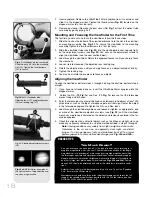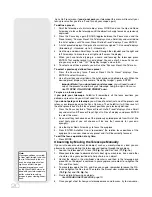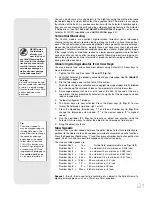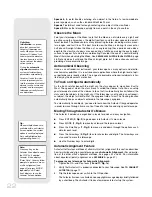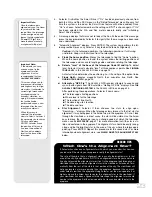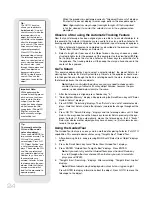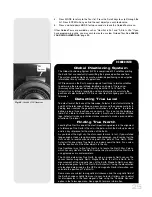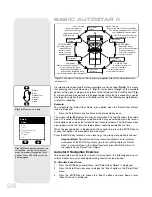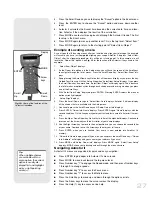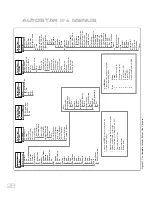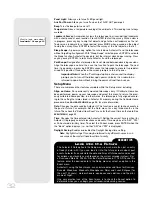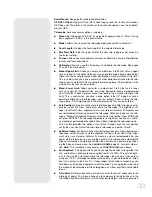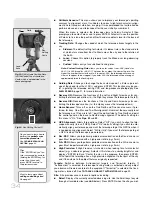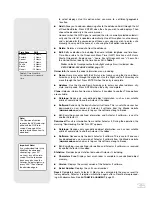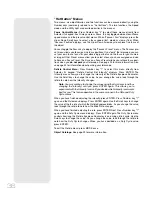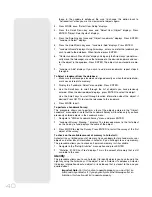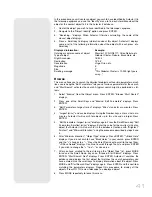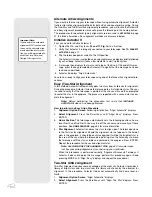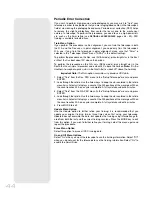
30
Identify:
An exciting feature for an observer who wants to scan the night sky and start
exploring. After the telescope has been properly aligned, use the Autostar II Arrow
keys to move about in the sky. Then follow this procedure:
Important Note:
Only use the Arrow keys to move the telescope during
the Identify procedure. Do not loosen the telescope locks or move the
base or alignment is lost.
1.
When a desired object is visible in the eyepiece, keep pressing MODE until the
“Select Item: Object” menu is displayed. Press ENTER to select this menu.
2.
Scroll through the Object menu options until the “Object: Identify” screen appears.
3.
Press ENTER. Autostar II searches the libraries for the identity of the object being
observed.
4.
If the telescope is not directly on an Autostar II library object, the nearest library
object is located and displayed on the screen. Press GO TO and the telescope
slews to that object.
Browse:
Allows you to search the library for objects with certain parameters, much
like a search engine. "Edit Parameters" lets you set various parameters for the search,
such as: Object Type, Minimum Elevation, Largest,
etc
. Once you have set the param-
eters of the search, select "Start Search" and press ENTER. Autostar II will display the
results of the search.
Event Menu
The Event menu provides access to dates and times of astronomical events. The
Event database includes:
Sunrise, Sun Transit,
and
Sunset:
Calculate the time of Sun rise, Sun transit, or Sun
set on the current date. Find rise and set times for other dates by entering a new date
into the “Setup: Date” menu.
Moonrise, Moon Transit,
and
Moonset:
Calculate the time of Moon rise, Moon tran-
sit, or Moon set on the current date. Find rise and set times for other dates by enter-
ing a new date into the “Setup: Date” menu.
Moon Phases:
Displays the date and time of the next Full, New, 1st Quarter, and 3rd
Quarter Moon.
Meteor Showers:
Provides information on upcoming meteor showers, such as the
Perseids, the Leonids,
etc.
Also lists the dates of the showers and when they reach
maximum.
Note:
Meteors are fast moving objects that cover large areas of the sky and
are usually best observed with the naked eye.
Solar Eclipse:
Lists upcoming Solar Eclipses, including the date and type (total,
annular, or partial) of eclipse. Use the Scroll Up and Down keys to display the avail-
able data. Remember, never use a telescope to look at the Sun! See
WARNING!
to the
left.
Lunar Eclipse:
Lists upcoming Lunar Eclipses, including the date and type (total, par-
tial, penumbral) of eclipse. Use the Scroll Up and Down keys to display the available data.
Min. (Minimum) of Algol:
Displays the minimum brightness of the dramatic eclipsing
binary star system, Algol. It is relatively close at a distance of 100 light years. Every
2.8 days during a 10-hour period, Algol undergoes a major change in apparent mag-
nitude as one of the two stars passes behind the other. The combined magnitude of
the two stars thus dips from +2.1 to a minimum of +3.4 halfway through the eclipse as
the second star is hidden. Autostar II calculates minimum magnitude time at mid-
eclipse.
Autumn
and
Vernal Equinox:
Calculate the time and date of the fall or spring equi-
nox of the current year.
Winter
and
Summer Solstice:
Calculate the time and date of the winter or summer
solstice of the current year.
WARNING!
Never use
your Meade®
RCX400
Telescope to look at the
Sun! Looking at or near
the Sun will cause instant
and irreversible damage
to your eye. Eye damage
is often painless, so there
is no warning to the
observer that damage has
occurred until it is too
late. Do not point the tele-
scope or its viewfinder at
or near the Sun. Do not
look through the tele-
scope or its viewfinder as
it is moving. Children
should always have adult
supervision while observ-
ing.
Want to learn more about
using the
Browse menu
?
See page 41.
Definition:
Transit
is the time when
the Sun, Moon, or other
celestial object crosses an
observer's meridian, i.e.,
the time when an object is
at its highest point in the
sky on any given date.
Summary of Contents for RCX400
Page 73: ......



